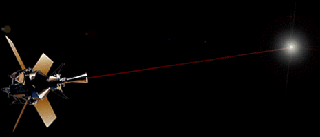
GP-B
Jump to: Mission Objectives, Mission Instrumentation, Mission Parameters, Additional Information
Mission Photos:

Courtesy of Stanford University
Mission Objectives:
Gravity Probe B (GP-B) is the relativity gyroscope experiment being developed by NASA and Stanford University to test two extraordinary, unverified predictions of Albert Einstein's general theory of relativity.
The experiment will check, very precisely, tiny changes in the direction of spin of four gyroscopes contained in an Earth satellite orbiting at 400-mile altitude directly over the poles. So free are the gyroscopes from disturbance that they will provide an almost perfect space-time reference system. They will measure how space and time are warped by the presence of the Earth, and, more profoundly, how the Earth's rotation drags space-time around with it. These effects, though small for the Earth, have far-reaching implications for the nature of matter and the structure of the Universe.
Mission Instrumentation:
Gravity Probe B has the following instrumentation onboard:
- Four gyroscopes
- Quartz telescope
- GPS receiver
- Retroreflector array
Mission Parameters:
| Sponsor: | United States |
| Expected Life: | 1-2 years |
| Primary Applications: | relativity experiment |
| Primary Applications: | precision orbit determination |
| COSPAR ID: | 0401401 |
| SIC Code: | 8603 |
| Satellite Catalog (NORAD) Number: | 28230 |
| Launch Date: | 20-Apr-2004 |
| RRA Diameter: | to be determined |
| RRA Shape: | Hemisphere |
| Reflectors: | 9 corner cubes |
| Orbit: | polar |
| Inclination: | 90 |
| Eccentricity: | 0.0014 |
| Perigee: | 650 km |
| Period: | 48.75 min. |
| Weight: | 3334 kg |




